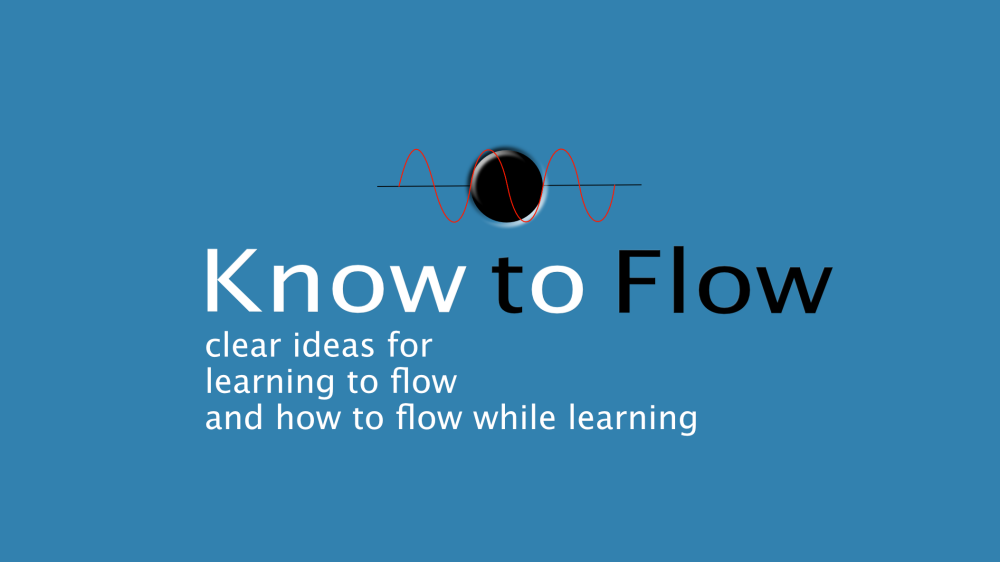Getting into the flow
Another term for being present
Flow is a mind-state where you notice change as it occurs. If you imagine time as a wave that travels through space, then being in the flow is when you are riding the wave of time. Instead of watching it pass you by, it carries you, and as a result time seems to slow down or stop.
Another way to think about flow (!!!) is that it is a state of mind (or consciousness) where you aren't thinking. You aren't worried about whether what you are doing is right or wrong. You are simply focused on what you are doing.
One of the reasons for getting into the flow is that it feels good. Another reason is that it can lead to better performance. It can also lead to you feeling like you are performing well even though you aren't! However, if you train, then you can maximize the possibility of performing well while in the flow.
A key part of learning to flow easily is understanding two different modes of consciousness. One of them is thinking and the other is flowing. Another part of getting into the flow, particularly when doing things that involve skill is understanding the idea of pre-thinking. All of that and more in learning to flow.
Bruce Lee told us to be like water. To be like water it helps us to understand water and in particular why it flows. Here's a look at understanding why water flows and how we can use this understanding to be like water (and flow).
One simple rule for getting into the flow is knowing what it is that you are trying to do. That's one reason for the title of the book, Know to Flow. When you know what it is that you are trying to do, getting into the flow is so much easier.
If what you are trying to do is complex, then you can know what you are doing by breaking the complexity down into simple elements that are clearly defined. You can then focus on doing those simple things without thinking.
All of this and more is covered in my ebook Know to flow.
A good question to ask is what does being in the flow have to do with yoga? I'll say that being in the flow is yoga. It's when you are focusing on what you are doing. And that basically means, not thinking. Learn more about this particular view of yoga in what is yoga?.
One of the defining features of flow is a lack of judgement. You aren't worried about whether what you are doing is right or wrong. You are simply focused on what you are doing. So when trying to get into the flow, let go of the idea of doing things right.
The Japanese refer to this as "No mind". You could also think of it as "not thinking". Read more about this state of consciousness in no mind.
You can also read about a similiar concept called Thin Slicing. This term is used by Malcolm Gladwell in his book "Blink" to refer to what could be thought of as "thinking without thinking". Read more about that in Thin slicing
Speaking of learning, one way in which flow can be important is as a part of the learning experience.
One way to think of flow is that it gives us a different perspective of life, and ourselves, than that offered by thinking. One way that we can use these two modes (flicking back and forwards between them) is to make learning more efficient, and more enjoyable. Read more about how we learn
In his book "Blink", Malcolm Gladwell uses the term "thin slicing" to refer to a process of "thinking without thinking".
It's like being in the flow, but instead of being in the flow and doing something effortlessly, it's being in the flow in such a way that ideas come effortlessly.
An important idea I learned from practicing Tai Ji is the difference between substansive and insubstansive. One transmits change readily, the other, not so much.
What's the big deal about these two "states"? The better you understand them, the easier it is to become aware of change. And that in turn makes it easier to get into the flow. Read more about managing change.
One way to make it easier to get into the flow, particularly when trying to learn to use the body, is to have a set of basic principles, simple rules we can use to guide the way that we use our body. Actually, these basic principles are so basic, they can also be applied to relationships outside of the body. Find out more in Muscle control principles
To understand more about consciousness I've written this rather lengthy article: understanding consciousness.
For a more thorough look at flow, check out the ebook Know to Flow. It covers a large portion of the philosophy behind this website and everything else that I do.
Published: 2020 01 12
Updated: 2020 08 15



